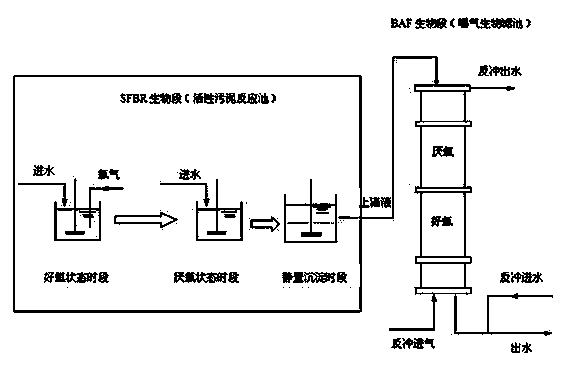Sequence fed-batch reactor and biological aerated filter (SFBR-BAF) biological nitrogen and phosphorus removal technology
A technology for denitrification, phosphorus removal, and biological treatment. It is used in biological water/sewage treatment, water/sewage multi-stage treatment, water/sludge/sewage treatment, etc. Poor impact resistance and other problems, to achieve the effect of strengthening the treatment effect and reaction speed, preventing sludge bulking, and preventing inhibition
- Summary
- Abstract
- Description
- Claims
- Application Information
AI Technical Summary
Problems solved by technology
Method used
Image
Examples
Embodiment Construction
[0030] A biological treatment method for denitrification and phosphorus removal of sewage, including two main biological sections of SFBR and BAF:
[0031] In the SFBR biological section, an activated sludge reaction tank is set up. The microorganisms in the activated sludge include nitrifying bacteria and denitrifying bacteria, and sewage is continuously (linearly or non-linearly) added to the reaction tank in a reaction cycle. The reaction cycle includes sequentially During the aerobic state period and the anaerobic state period, in the aerobic state period, aeration is carried out in the reaction tank for aerobic reaction, and the added sewage is nitrified by nitrifying bacteria to convert the ammonia salt in the water body into nitrate, and at the same time Part of the organic carbon is degraded or decomposed into carbon dioxide and water by aerobic microorganisms; during the period of anaerobic state, the aeration into the reaction tank is stopped for anaerobic reaction, a...
PUM
 Login to View More
Login to View More Abstract
Description
Claims
Application Information
 Login to View More
Login to View More - R&D
- Intellectual Property
- Life Sciences
- Materials
- Tech Scout
- Unparalleled Data Quality
- Higher Quality Content
- 60% Fewer Hallucinations
Browse by: Latest US Patents, China's latest patents, Technical Efficacy Thesaurus, Application Domain, Technology Topic, Popular Technical Reports.
© 2025 PatSnap. All rights reserved.Legal|Privacy policy|Modern Slavery Act Transparency Statement|Sitemap|About US| Contact US: help@patsnap.com

